Recommendation points
- How a glue gun works
- Basic and additional functions
- Comparative tool overview
- Hot glue types
- Basic rules of use
It is difficult to imagine a home workshop that does not have a thermal gun. This seemingly simple tool has its own peculiarities, the same applies to glue sticks. We offer a small educational program in which we describe the specifics of the choice of glue guns and consumables for it.
How a glue gun works
A thermo gun is an electric heating device designed to melt thermoplastic glue and dispense it. The design of the tool is simple to the point of primitivism, however, the technical design of various units may differ significantly.
The classic design is based on a heater – a narrow channel, the surfaces of which are carefully polished to reduce adhesion. The tube through which the glue melt moves has a massive metal shell, usually of aluminum, in which one or more heating elements are located. When assembled, this unit is called a melting chamber, the outer part of which is represented by a nozzle, from which hot glue protrudes.
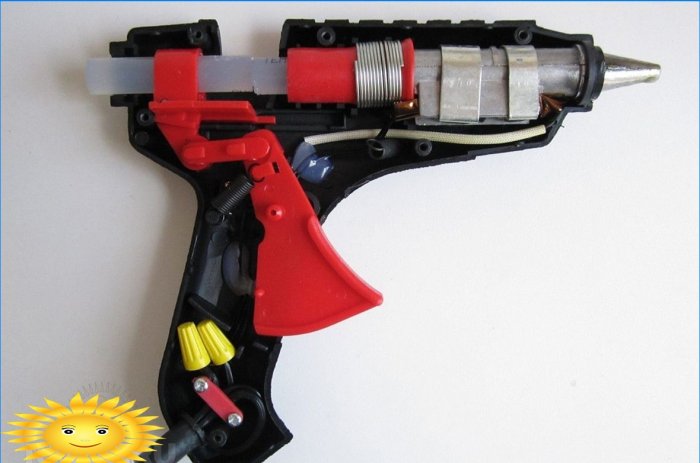
The mechanical feed device consists of a trigger that drives the pusher clutch. The trigger itself can move translationally in linear guides or by means of a swivel joint. The latter type of design is considered more successful due to the simplicity of the device and the ability to reduce the exerted force due to the correct distribution of the lengths of the lever arms. The clutch actuated by the trigger can be a conventional annular sleeve or have a tooth that protrudes during the forward movement of the pusher and disappears during the return stroke. There are also models with a petal clutch, arranged according to the collet principle, but in this version it is impossible to remove the glue stick that has not been completely consumed..

Most modern thermo guns have another element of the feed mechanism – a sealing sleeve. Its task is to prevent the rod from breaking when entering the heating chamber and to prevent excess melt from flowing back into the gun body. However, this structural element can harm the overall ergonomics: rods periodically jam in the bushing, and in case of insufficiently high-quality performance, the molten glue still protrudes slightly back and firmly glues the rod to the cuff, after which the tool becomes unusable forever.
Basic and additional functions
The classic design of the glue gun captivates with its simplicity and reliability, but it is not without its drawbacks. The main problem is the difficulty of accurately dispensing the glue protruding from the nozzle, which expands when heated and, since it cannot squeeze the rod in the opposite direction, gradually seeps out.
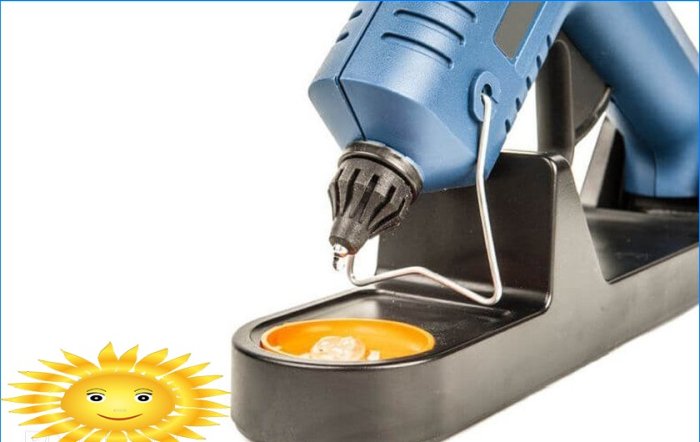
To eliminate this disadvantage, two technical solutions are provided. The first is a push-down release button that opens the push rod mechanism and allows the rod to move slightly in the opposite direction. The second solution is to regulate the temperature and automatically reduce the power of the heater when the operating temperature is reached, thereby reducing the thermal expansion of the adhesive.
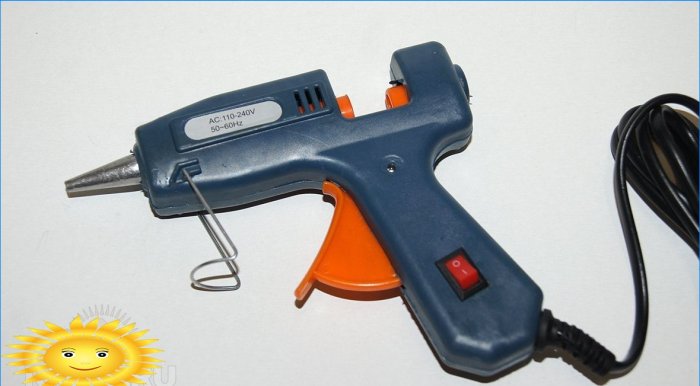
Most modern glue guns are designed with a hinged bracket located under the nozzle to ensure that the gun remains stable in standby mode. Also, a viewing window can be located at the rear of the body, allowing you to monitor the consumption of the rod and the state of the pusher mechanism. Some models of pistols can be equipped with a toggle switch on the handle, illumination, replaceable nozzles, stand, power cord disconnect, trigger travel stop and some other “gadgets” to facilitate ease of use. The shape of the body and trigger can be very diverse, the ergonomic features of the tool should be selected based on your own preferences and conditions of use.
Comparative tool overview
To finally clarify the key differences between hot glue guns, let’s compare the most popular models. In total, three classes of such a tool can be distinguished:
- for decoration and hand-made products (power up to 50 W);
- for household and everyday use (100-150 W);
- for installation work (over 200 W).
In each category, one can single out a pair of outstanding representatives with peculiar differences..
Intertool RT-1009can be called one of the most budgetary options for a tool, perfect for gluing small parts. The power of the heater is very modest – only 10 W, while the gun is really miniature, it fits easily even in a child’s hand and weighs only 170 g. The tool is designed to use rods with a diameter of 7 mm, it can produce up to 10 g of glue per minute.
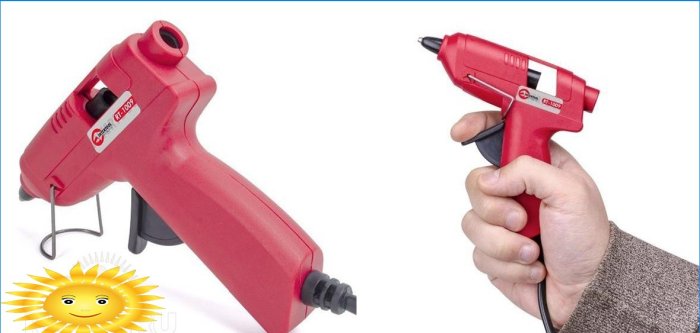
BOSCH Glue Pen– the absolute opposite of the first representative of low-power pistols. This option is perfect for professional craftsmen, whose work requires accurate and precise gluing of miniature elements. This glue gun surprises with its non-standard form factor and battery power. Its main feature is almost instant access to the operating temperature, the possibility of continuous operation for an hour and automatic suction of glue residues. The pistol is “fed” by rods with a diameter of 7 mm.

Dremel 940– a representative of an already more serious line of tools, suitable both for everyday tasks and for making various kinds of crafts. Power of 100 W is enough to dispense 18 grams of glue per minute, while the gun has well-developed ergonomics and overall reliability of the assembly. Of the additional options, only a set of three interchangeable nozzles and a toggle switch on the handle are noteworthy, otherwise it is just a reliable workhorse for a home workshop.
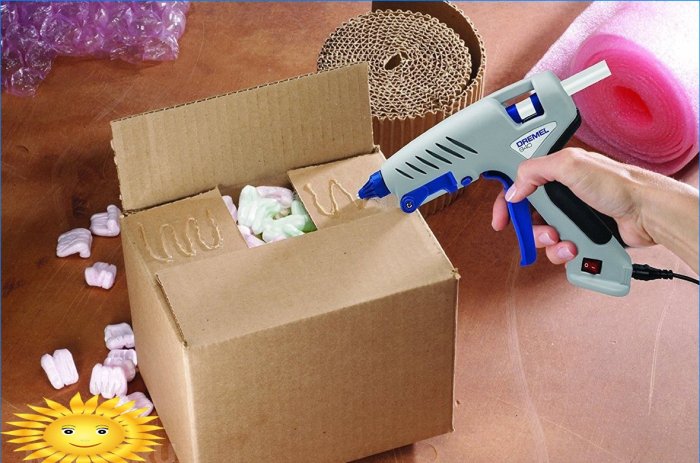
Steinel gluefix– a cheaper analogue in the middle power segment. A 175 W heater is capable of heating the adhesive up to 200 ° C, providing a performance of at least 13 g / min. This tool does not differ in any bells and whistles – just a comfortable body with good ergonomics and, as it should be for most thermal guns of this class, electronic temperature control.

KWB FL007– a representative of the line of high-performance thermo guns with a 200 W heater. After reaching the operating temperature, it can produce more glue than stated in the passport, approximately about 18–20 g / min. A distinctive feature is a silicone cover on the nozzle, which increases safety of use and makes it easier to clean glue drips. The disadvantage of the tool is, perhaps, a too powerful heater: due to overheating, the glue constantly oozes from the nozzle, it is required to periodically manually pull the rod a little in the opposite direction. However, for its price segment, this pistol is a very worthy representative..

Elmos EGG 330– perhaps one of the most advanced glue guns. With a power of 300 W and maximum heating up to 230 ° C, it has a manual temperature setting and a pusher force adjustment. The original tool is supplied in a plastic case and comes with three replacement nozzles and several glue sticks. Ideal for mounting large parts, repairing skirting boards and floor coverings, this gun can melt up to 25 g of adhesive per minute. In general, the Elmos line includes a dozen models, among which there are guns with a power of up to 600 W and with a pneumatic glue feed.

Hot glue types
Hot gun glue is often referred to as silicone, although this is not the case. The rods are made from several types of thermoplastic plastics, each polymer is designed for bonding different materials and provides for different operating modes. The key difference lies in melting temperature and time, which is why professional guns have a heating control..
The most common hot melt adhesive is ethylene vinyl acetate (EVA), because of the characteristic smell of this polymer when melted, it was called silicone. The rods have a translucent whitish color, it is the most fusible glue, its working temperature is 120–130 ° С. Plus, EVA is the most fluid type of glue, it fills the pores with the best quality.
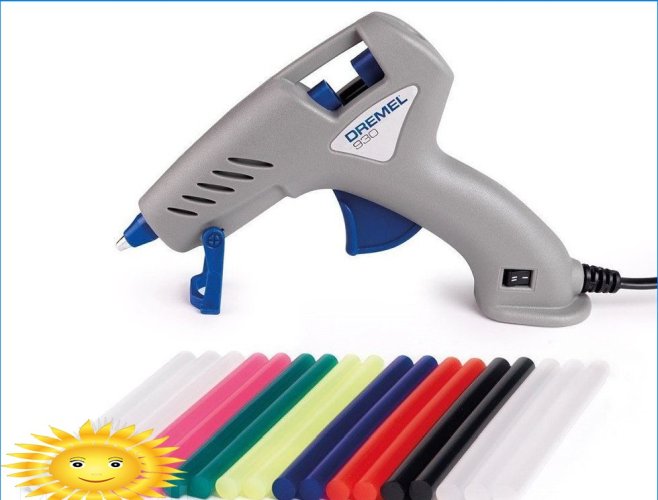
Unlike household types of glue, which are not intended for making critical joints, polyamide, as well as polyethylene and polypropylene adhesives have higher strength and hardness. Their melting point is higher, as a rule, such glue must be heated to at least 200 ° C. In the unpainted state, the rods are either white opaque or yellow translucent.
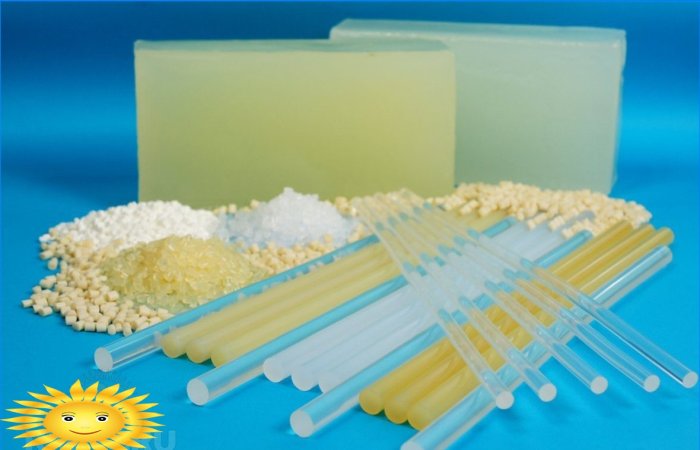
Also, the glue can be colored in accordance with the color of the parts to be glued to mask the seam. The exception is the black and gray opaque rods, which, in fact, are not adhesive. These are sealants designed to fill joints between mechanically fastened parts..
Basic rules of use
Craftsmen who are just getting started with thermoplastic adhesives are often frustrated by the insufficient quality of the gluing. In fact, all types of hot melt adhesives have high strength and excellent adhesion to all materials except polyethylene, as well as loose structures such as plaster..
To make a good connection, careful preparation of the bonded surfaces is required. They must be degreased and wiped dry; in some cases, abrasive cleaning of the contacting parts can be recommended to increase the roughness. Particular attention must be paid when gluing massive parts with a high heat capacity: in order for the glue to flow into the pores, the surfaces must be preheated with a construction hair dryer.
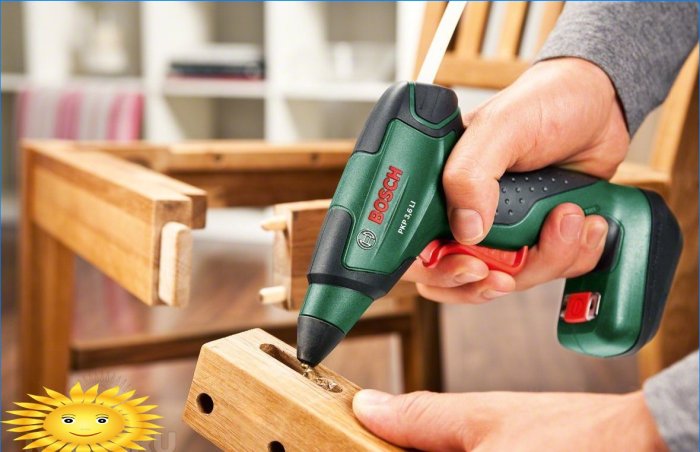
Finally, we will give some important recommendations. Before starting the first experiments with a thermal gun, it is necessary to acquire a small low capacity, which is placed under the nozzle of the gun installed on a stand. Almost all pistols leak, the only question is the amount of leakage, the capacity will allow collecting protruding excess. For convenient work, you should learn how to choose rods: even small deviations from the nominal diameter can lead to the fact that the pusher clutch will slip and the rod must be pushed manually. Most budget hot melt glue guns have this drawback..

How can one go about purchasing a thermal gun? Are there any specific factors or features that should be considered while selecting the appropriate glue for it?
I’m interested in purchasing a thermal gun, but I’m a bit unsure about how to go about it. Could someone guide me on the process of buying one? Additionally, I’m also curious about the suitable adhesive or glue to use with it. Could anyone suggest a reliable option for optimal performance? Thanks!